“Nothing is more powerful than an idea whose time has come.”
– Victor Hugo
“Design is really an act of communication, which means having a deep understanding of the person with whom the designer is communicating with.”
– Donald A. Norman, The Design of Everyday Things
For decades, critical analysis has held sway in business problem-solving protocols. The process involved breaking down intricate complexity into smaller components in order to figure out the specific issue. Analysis of this sort is achieved by understanding the individual parts. Unfortunately, this exercise has become mandatory on some level because today’s business world can be unpredictable and easily disrupted. So for organizations to both survive and thrive, new methods need to be generated that embrace the volatile nature of contemporary business from a creative perspective. Essentially, it’s an evolutionary practice derived from creative thinking, which involves a company’s full team effort.
In the past, design was relegated to those members of the team who were considered actual designers-the people tasked with taking ideas and turning them into “things” that deciphered the predicament at hand. While this approach had some successful results, it often left much to be desired. One integral issue to this particular technique is that the organization’s entire workforce was excluded from contributing ideas to be built upon and expanded. To move forward and obtain better results, some business thinkers began to examine the process design professionals used to reach their previous conclusions. The goal was to expand this approach and embrace professionals from all areas of the business. Out of that more enlightened mindset, the whole concept of design thinking emerged.
Design thinking is not new. Its origins can be traced back to Herbert Simon’s 1969 book “Sciences of the Artificial” (MIT Press, 1969). But only now is it gaining respect and momentum as it piles up success after success, especially in software development.
The Four Principles of Design Thinking
At its core, design thinking is a powerful, repeatable process that questions everything, relies heavily on observation, demands options and promotes experimentation. It also has the built-in ability to see forward beyond the current dilemma to be addressed. As a prime example of such innovation, Boeing no longer just sells jet engines. Now it provides an entire uptime system that incorporates the engine mechanism itself. In addition, it has an advanced communications network and worldwide performance data collection mechanism that largely insulates it from maintenance issues and safety monitoring. This approach shows design thinking at work to make vital improvements that create a lasting impact on the product and on the actual marketplace.
Among the fundamental principles of design thinking, four concepts stand out as departures from prior systems that had been considered the norm. The four notions below epitomize what it means to think outside of expected boundaries. Consequently, a product of even greater value has the potential to form, enhancing both the company and the general public’s quality of life at the same time.
All team members involved in the design thinking process are “designers.”
This idea especially applies to the customer. In fact, when it comes to design thinking, customers are the premier source of inspiration and problem definition. They do the “heavy lifting” and provide the bulk of the mental input that makes the product successful in the marketplace. Furthermore, customers reveal what people really do as opposed to what they are thought to do.
With this knowledge, it then falls on the team to synthesize this insight into research, using the observations and the data collected. Any team member can have insight. Design thinking reasons that six people thinking for one hour will produce more productive perceptions than just one person thinking for six days. The trick is to be freed from the restriction of: “this is the way we’ve solved a problem before.” Instead, questioning and asking “Why?” become the mantra that leads to progress. Plus, it’s an important foundation because it leads directly to the second important principle.
Take nothing for granted.
Defining and revising any opportunity into its simplest definition is key. This is because all of us-all human beings-naturally gravitate toward solutions that are as uncomplicated as possible. So “design a chair,” for instance, becomes “design a way for a person to suspend comfortably in a non-standing position.” That slight shift in method opens up the possibility for all sorts of amazing ideas.
There are no judgments in design thinking.
After the right problem has been defined in a way that invites creative solutions, many alternatives must be developed for consideration without censorship. Promising insights need to be nurtured and protected. It doesn’t matter how obvious the solution may seem. The compelling exercise of examining a defined problem from more than one perspective is guaranteed to reward richer results. A good example of this phenomenon is the way Airbnb resolved a perplexing financial obstacle. The founders of this accommodations Website were faced with tepid interest and disappointingly low income when they first launched. Sadly, the make or break point was fast approaching. In desperation, they reviewed all 40 of their locations in New York City. To figure out how to boost enthusiasm for their service, they talked to property owners. The places ranged from upscale to modest in varying neighborhoods. After a thorough analysis, the only common point they could find between listings was that all of them had unappealing pictures – cell phone saps and bad photos – the kind that can be found in any classified ad. Putting aside judgment and doubt, they flew to New York, rented a good camera system and photographed their clients’ apartments properly as a real estate agent would. Within weeks, income had doubled and the rest is history.
There is no winner until there is a winner.
Even when a winning idea is selected, there’s still room for greater improvement. And the only way to get there is to test, try and reformulate. Failure at this point is a gift that provides inestimable learning. The negatives of “why” something can’t be done must be put aside. “Previous experience” only kills many potential ideas. Protect all promising ideas at the beginning, no matter how far-fetched they may seem.
To winnow the pile, go back to the source, the customer, who is the ultimate “designer.” Commit small funds to test promising solutions. Try out a prototype. What looked good in concept may not cut it in the real world. Reformulate and improve until there is a solution that delivers the winning results. But don’t stop there. Often the byproduct of the design thinking process is the generation of other unique ideas. They may be parallel to the going-in objective or they just might add a boost down the road as the strategy unfolds.
As design thinking has evolved and grown in popularity and results, many protocols have materialized. Some incorporate seven steps, others four or only three. It really doesn’t matter which protocol is followed because they all come from the same place—a proven methodology that seems to deliver when implemented correctly. In basic terms, it comes down to one thing. When design becomes a process of action, a verb not a noun, it rises to design thinking. Once it’s applied to the whole problem-solving exercise, the capabilities become compelling because they intimately involve everyone, assume nothing, embrace failure as part of the process and seek the simplest, most intuitive solution possible.
But in order to reach this place of unlimited creativity, where possibility is not restricted by complicated rules and cemented organizational standards, it takes creative leadership. The fact is that design thinking requires sustained courage that must start at the executive level.
How Design Thinking Builds on Design Concepts
Although design thinking derives from principles of design, there is a tendency to diminish this concept to the improvement of appearances alone. But design of any sort is so much more than enhanced exteriors. It is about the limitless possibilities that human intelligence offers. So while the act of designing something certainly involves making it look good, this process goes deeper than the outer surface. In fact, it extends to the heart of any kind of system in order to promote further development.
To be sure, every design serves as a pioneering step that innovates in some way, bringing new ideas into existence. With this knowledge in mind, it’s logical to apply design techniques that can open fresh pathways to strengthen companies from the inside. The image below illustrates how organizations have the capability to administer design strategies for their creative benefit.
How Organizational Leaders Can Promote Design Thinking
To achieve the advanced results that come with creative thinking from a design outlook, empowering an organization’s team is of paramount importance. This means that leaders must adopt a range of pivotal roles that can facilitate a culture of inventiveness and bold ideas.
First and foremost, those in charge have to convey a vision that employees can grasp as a foundation. This basis will allow for greater risk-taking in the experimentation process because the ultimate objectives are much more clear.
In addition to this necessary imagination, leaders need to be prepared to inspire. While design thinking promotes simplification as a means of expansion in new directions, it is not an easy task. Inevitably, there will be lows caused by dead-ends or obstacles that impede growth. But when leaders take on these challenges, determining effective ways to address problems as they arise, then there is always room for adjustment. Therefore, the team understands that issues can be confronted successfully in order to continue pushing ahead to achieve the organization’s goals.

In basic terms, design thinking is about creating a structured framework with innovation as the subsequent goal. It’s a process that encourages meaningful growth that also provides genuine advantages to your customers. Throughout all of the experimentation and associated dynamics that come with leading a workforce determined to formulate new pathways, this desired framework should never be overlooked as a vital objective.
Applying Design Skills to Attain Organizational Improvement
The use of design thinking means implementing techniques that may not seem intuitive to company managers at first. But by combining right brain imagination with left brain logic, there’s no telling how far a business can go with a design thinking mentality.
Effective design thinking demands observation, interviewing, creating personas, developing storyboards, making prototypes and performing decision-making analyses. In short, the process requires a whole brain approach, where learning comes with doing the work of overall design.
Design Thinking for Companies Today and Tomorrow
It may seem intimidating to consider innovation from a design perspective. But the truth is that you don’t need to be a trained designer to develop this all-important mindset. Even though learning the skills to be a good designer often requires many years of focused devotion, that does not mean you can’t embrace design strategies for your company right now.
Just by implementing some of the above approaches to leading, managing, simplifying and creating, you are, indeed, designing. The process of bringing your company’s vision to life with design thinking techniques can only enhance the products you have to offer while providing an invaluable service to customers today and in the promising years ahead.
Want to learn more about design thinking, agile, or other methodologies? Get in touch with Sphere today.





